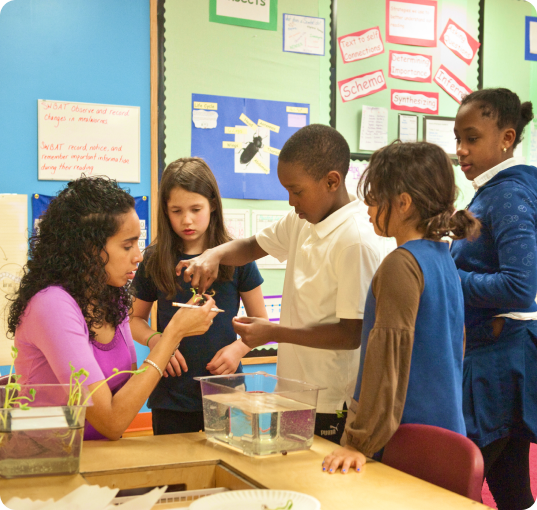Enroll in Primary Science Tuition Singapore for a Strong Science Foundation
Enroll in Primary Science Tuition Singapore for a Strong Science Foundation
Blog Article
A Comprehensive Guide to the Numerous Understanding Techniques in Primary Scientific Research Guideline
The expedition of diverse understanding methods in primary scientific research instruction presents a possibility for instructors to enhance trainee involvement and understanding substantially. By taking a look at hands-on learning strategies, inquiry-based approaches, and joint methods, we can recognize reliable practices that provide to different finding out styles.

Hands-On Learning Methods
Hands-on learning methods play a pivotal duty in key scientific research guideline, involving students in energetic expedition and experimentation. These methods permit learners to interact straight with products and sensations, cultivating a deeper understanding of clinical concepts. By utilizing manipulatives, designs, and real-life experiments, instructors produce a setting where pupils can observe, assume, and examine their ideas.
Such techniques not just boost comprehension yet likewise grow crucial thinking and analytical skills. When pupils get involved in activities like constructing basic makers, planting seeds, or performing chain reactions, they are urged to ask concerns and seek responses via their own observations. This experiential approach assists to demystify intricate scientific principles, making them more obtainable and relatable.
Additionally, hands-on learning promotes partnership among peers, as trainees often work in teams to perform experiments or share searchings for. This synergy not just improves their knowing experience yet also develops important social skills. Inevitably, incorporating hands-on techniques in key scientific research direction promotes a lifelong love of knowing and inquisitiveness about the environment, laying a solid structure for future scholastic searches in science and beyond.
Inquiry-Based Learning
Inquiry-based learning is a training approach that motivates trainees to ask inquiries, investigate sensations, and build their own understanding of clinical concepts. This technique changes the focus from traditional teacher-led direction to a more student-centered experience, where students take the effort in their educational trip. By fostering inquisitiveness, inquiry-based learning promotes much deeper engagement with the material, allowing trainees to explore subjects in a significant context.
In method, this strategy commonly entails hands-on experiments, monitorings, and essential thinking activities that line up carefully with the clinical approach. Pupils are motivated to develop theories, style examinations, and assess data, which cultivates essential skills such as analytic and logical thinking. The role of the educator in this structure is to facilitate expedition, guiding students through the inquiry process while urging independent thought and collaboration.
In addition, inquiry-based discovering nurtures a sense of ownership over the understanding procedure, encouraging students to go after expertise actively. This method not just enhances understanding of scientific concepts but additionally promotes a lifelong love for understanding, equipping pupils with the skills essential to navigate a significantly complex world.
Collaborative Discovering Approaches
Joint understanding strategies empower students to involve in significant interactions with peers, promoting a common responsibility for their academic results. In main scientific research direction, these approaches encourage students to interact to discover clinical ideas, address troubles, and perform experiments (primary science tuition Singapore). By joining group tasks, trainees can utilize diverse point of views, permitting richer understanding and retention of scientific understanding
One key element of collaborative learning is the emphasis on interaction skills. Students should articulate their ideas, pay attention actively to others, and work out ideas, all of which are essential expertises in both real-world and scholastic contexts. This social interaction not only enhances their understanding of scientific concepts yet additionally advertises synergy and conflict resolution abilities.
When pupils see the value of their payments within a team, they are extra likely to take possession of their knowing journey. Generally, integrating joint discovering methods in key science direction cultivates a dynamic understanding setting that prepares students for useful reference future academic and social challenges.
Modern Technology Assimilation in Science
The assimilation of modern technology in primary scientific research direction enhances learning experiences by supplying ingenious devices and sources that sustain various training techniques, including collaborative learning - primary science tuition Singapore. The use of electronic platforms, simulations, and interactive applications enables pupils to involve deeply with clinical concepts, helping with an extra hands-on approach to understanding
Virtual labs, for instance, enable students to conduct experiments safely and effectively, promoting inquiry-based understanding. These tools can replicate real-world scientific scenarios, permitting students to visualize complex procedures that would certainly be hard to reproduce in a conventional class setting. Moreover, modern technology cultivates interaction and cooperation amongst pupils, as they can share searchings for and function with each other on projects with online platforms.
In addition, multimedia discussions and educational video clips can improve lessons by satisfying diverse understanding designs, making abstract principles much more easily accessible. Information analysis devices additionally equip trainees to gather and analyze scientific data, reinforcing crucial believing skills. On the whole, the critical consolidation of innovation in key science guideline not only improves interaction yet likewise prepares pupils for a technologically advanced culture, outfitting them with crucial abilities for future clinical undertakings.
Differentiated Guideline Techniques
Set apart guideline methods are important for addressing the diverse needs of learners in primary science education and learning. These approaches make it possible for educators to tailor their teaching methods to fit varying capacities, passions, and learning styles within the class. By employing set apart instruction, teachers can develop an inclusive environment that promotes interaction and improves understanding of clinical principles.
One efficient technique is to make use of versatile grouping, which allows trainees to work together with peers at similar ability levels or with differing viewpoints. This method motivates peer understanding and advertises vital reasoning. Additionally, using options in assignments can equip trainees, permitting them to choose projects that reverberate with their passions while still satisfying curricular purposes.
Moreover, integrating tiered jobs is one more important technique. By creating jobs with varying levels of complexity, instructors can ensure that all students are suitably challenged, regardless of their effectiveness. Using developmental evaluations to determine comprehending further makes it possible for educators to readjust their training methods dynamically, guaranteeing that each see here now learner receives the assistance they require.
Ultimately, implementing distinguished direction techniques in key science education not just improves trainee discovering outcomes yet additionally cultivates an enthusiasm for science, preparing trainees for future academic searches.

Final Thought
In recap, reliable main science guideline necessitates a diverse technique that encompasses hands-on learning, inquiry-based approaches, and collective techniques. The combination of modern technology and set apart guideline better accommodates varied knowing designs, promoting a setting helpful to expedition and important thinking. By implementing these techniques, educators can discover here improve pupil interaction and understanding, eventually nurturing a long-lasting interest for scientific research and questions. Such extensive techniques are crucial for establishing informed and curious future scientists.
The exploration of diverse learning methods in primary science instruction provides a possibility for educators to improve pupil involvement and understanding significantly.Hands-on discovering techniques play a critical role in main science guideline, engaging pupils in energetic expedition and trial and error.Inquiry-based discovering is a training approach that urges students to ask concerns, explore phenomena, and create their own understanding of clinical principles.Joint learning approaches equip trainees to engage in significant interactions with peers, fostering a common obligation for their instructional outcomes. On the whole, integrating collaborative understanding strategies in primary scientific research direction grows a dynamic understanding setting that prepares students for future scholastic and social obstacles.
Report this page